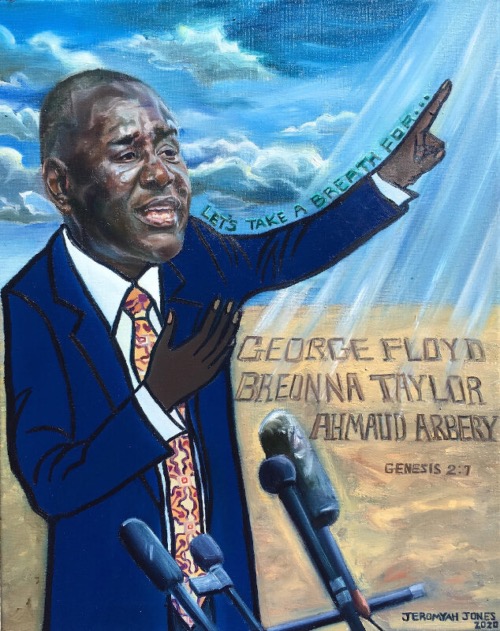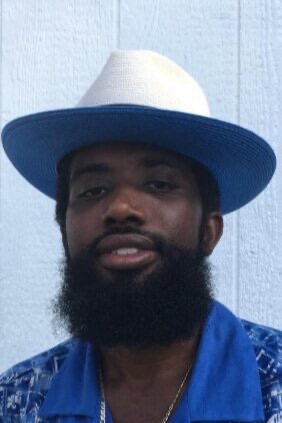
JILLIAN CHENEY, of Religion Unplugged meets US artist Jeromyah Jones…
Jeromyah Jones, a 30-year-old painter from Richmond, Virginia, watched with the rest of the world as George Floyd’s death inspired global protests. He was particularly struck by a call to action from civil rights lawyer Benjamin Crump, who encouraged his audience to “take a breath for” dozens of victims of police violence.
He began to think of Genesis 2:7, in which “the LORD God formed the man of dust from the ground and breathed into his nostrils the breath of life, and the man became a living creature.”

Jeromyah Jones’ painting, titled ‘The Fight to Breathe’. PICTURE: Provided by Jeromyah Jones.
“I began to see this parallel, and I think it’s sad how some people don’t value the gift that the Almighty gave each and every one of us because they don’t like the colour of that person’s skin,” Jones said. “That gift of breathing should be appreciated by everyone.”
So Jones began to paint. The result was a painting he called The Fight to Breathe, and it depicts Crump pleading for the living to take a breath to honour the dead. He points to a light coming from heaven. The names of George Floyd, Breonna Taylor and Ahmaud Arbery are in the dust behind him.
Jones said he felt a responsibility to create such a painting, as he makes art that intentionally combines the reality of being black with a Biblical spirituality.
“Art was always around me,” Jones said. His father is a painter, and the two frequently attended art exhibits in his childhood. He started painting when he was three or four-years-old, and he had his first solo art show when he was in 10th grade.
Jones points out, though, that he wasn’t required to follow in his father’s footsteps. His parents taught him more about the Bible than they did anything else, with the belief that a foundation in Scripture would allow him to be successful in any career he decided to pursue. So art “kind of became a natural love,” he said.
His painting technique involves a combination of classical realism and modern art: the heads and faces are detailed and realistic, but the bodies are matte and two-dimensional. This inspiration comes from Jones’ love of the classical realism movement and Jacob Lawrence’s The Migration Series.
Since he began pursuing art as a career, Jones has put on several shows in his hometown. He’s done two significant shows with his father, who still paints as well. The first, in 2018, was titled Prophecy Makes History and addressed the history of racism in Richmond – especially its past as the capital of the Confederacy during the Civil War.
The second, in 2019, involved the creation of the I AM 400 banner, to recognise the 400-year anniversary of the first enslaved Africans being brought to Virginia. Each painting in the banner represents a portion of black history, celebrating public figures, celebrities and roots of African spirituality. It is meant to recognise the struggles of black people and celebrate their successes in what Jones hoped would “commemorate and educate the public on who we are as a people”.
In this project, Jones cites the importance of Genesis 15:13: “Then the LORD said to Abram, ‘Know for certain that your offspring will be sojourners in a land that is not theirs and will be servants there, and they will be afflicted for 400 years.’” The verse refers specifically to the Israelites in their persecution by Egypt, but Jones said it’s just as applicable to the plight of black people in America. 
The ‘I AM 400’ banner by Jeromyah Jones and his father, Jerome. PICTURE: Provided by Jeromyah Jones.
These connections to the Bible are what makes art worth pursuing, Jones said.
“I wouldn’t say that I actually began to love [art] until I realised that the message should be, in my opinion, more important than the sum of its parts,” he said. “So it should be more important than the elements of design, the shapes, the lines that make up the physical composition.”
This message found in his art is a simple one. “My mission has been to turn Scripture into pictures,” Jones said.
He focuses on the intersection of the Bible and black history, from the beginning of slavery in Africa to racial injustice in modern America.
This is what Jones believes his calling as an artist is. “It’s important for artists to not only look at the surface of what we are seeing in our society today, but it’s also important to read in between the lines of what we’re seeing,” Jones said. “And the Scriptures tell us how to do that. The Bible is not only a book of yesterday; it is a book of today, and of tomorrow.”

Jeromyah Jones.
He uses his knowledge of the Bible and skill of painting to help pose specific questions and themes – about the sanctity of life, the suffering of black people and Biblical justice – in order to help educate viewers on perspectives they may not have seen or understood before. This, he says, also helps black Americans reclaim a historical narrative that is for the most part written with a Eurocentric focus.
“I think it’s important for artists to share the other side of history – or a more correct version of literature,” he said.
In order to do this, Jones says, artists must focus more on the message than what he calls “art for art’s sake”, which just portrays the specific thoughts of the artist and is meant more to go over viewers’ heads than to speak to the everyday man and woman.
Jones wants to use his art for an activism that educates and creates change for black people who have been marginalised, even in his own hometown. But more important than both his art and his desire for racial justice is the spirituality that connects him to God.
“I want my work to be a vehicle to direct people to the Most High,” he said. “I want to convey that even when we deal with these social issues, the solution is still spiritual.”
Jillian Cheney is a Poynter-Koch fellow for Religion Unplugged who loves consuming good culture and writing about it. She also reports on American Protestantism and Evangelical Christianity. You can find her on Twitter @_jilliancheney.





